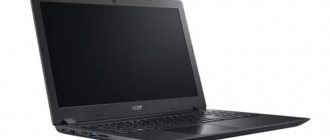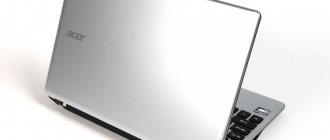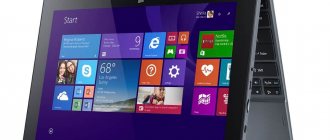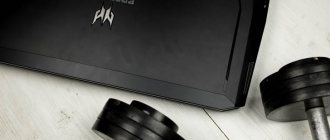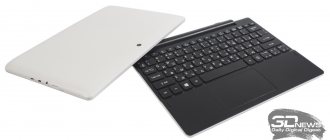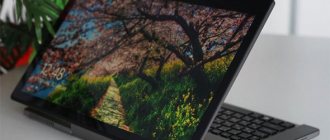Joke
The first impression of the M3 is described something like this: “You must be joking! Something this thin can't be a gaming laptop." Judge for yourself: the M3 looks like a small black folder with documents. No frills: a rectangle with curves at the back. The height is only 20 mm, which is 4.5 mm less than the Apple MacBook Pro, famous for its modest size. The main material is high-quality matte plastic. The entire lower half is made of it. The top one was made from a solid aluminum plate, decorated with a mirrored Acer logo. Note that the screen here is only 4 mm thick.
There is nothing interesting on the bottom: a lot of ventilation holes and a cover that provides access to the hard drive and RAM. It is curious that the battery is closed; it is not possible to turn off the power to the computer when it freezes. It is proposed to use a button recessed into the base, which can only be reached with a needle. Inside, the M3 looks no less strict - the same dark plastic. The only decorative elements are a gray backing under the keyboard and a couple of white inscriptions.
Relative temperature
| Top | Bottom | |
| 4.6°C | ||
| 14.9°C | 13.1°C | 3.8°C |
| 7.7°C | 10.3°C | 3.2°C |
| 7.4°C | 16.8°C | |
| 3.4°C | 12.9°C | 17.9°C |
| 4°C | 9.3°C | 8.3°C |
- the result of the difference between the temperature of the case and the room temperature.
[/td]
An excellent result, even despite the system operating for a long time under high load.
To assess the temperature conditions inside the case, you can look at the screenshot from the CPUID Hardware Monitor program, which worked throughout the entire test and recorded sensor readings of installed components in various modes of laptop use:
BATTERY
For offline operation in ACER Aspire TimelineX 4830TG
6-cell Li-ion
battery with an increased capacity of
66.6 Wh
(10.8 V, 6100 mAh) is used The battery is not removable. It's no secret that there are situations when you need to remove the battery from the case to restart the laptop. This trick does not work with built-in power supplies. To correct this fact, the manufacturer suggests using a small hole on the bottom: just insert a straightened paper clip into it with the sharp end, and the electrical network will open, simulating removing the battery.
A 90-watt power supply is used to charge the battery.
power supply (19 V, 4.72 A). The charger plug has a very convenient L-shape. Thanks to this, the cord will not stick out from the laptop like an antenna, but will be compactly located along the body.
Since the laptop has two video cards, we ran several rounds of tests for each graphics core.
| BE Classic, discrete graphics card priority BE Classic, integrated video card priority |
Classic mode, BE Classic
, 100% matrix backlight brightness, “High Performance” mode, Wi-Fi active.
1) Discrete video card. Result: 2 hours 44 minutes.
2) Integrated video card.
Result: 2 hours 51 minutes.
| BE Reader, discrete graphics card priority BE Reader, integrated video card priority |
Reading mode, BE Reader
, 40% matrix backlight brightness, “Energy Saving” mode, Wi-Fi active.
1) Discrete video card. Result: 9 hours 15 minutes.
2) Integrated video card.
Result: 11 hours 6 minutes.
almost 3 hours to fully charge the battery with a 90-watt power supply.
.
| Battery charge time graph |
The results are simply magnificent: just charge the ACER Aspire TimelineX 4830TG
and he will spend the whole day quietly without the need to connect a charger.
Test results in BatteryEater (classic), min.
| Laptop Acer Aspire One 532h-2Ds | 325 |
| Laptop Acer Aspire 4810TG – 354G32Mi | 242 |
| Laptop Asus UL50Vt | 238 |
| Laptop Asus UL80Vt | 229 |
| Laptop Acer TravelMate 8371 – 353G25i | 223 |
| Lenovo ThinkPad X200s laptop | 204 |
| Laptop Asus UL20A | 183 |
| Laptop Acer Aspire TimelineX 4830TG – 2313G50Mnbb | 165 |
| Laptop Lenovo IdeaPad U450P – 2Wi | 153 |
| Laptop Acer Aspire TimelineX 4820TG – 434G50Mi | 97 |
| Larger index values are better | |
Test results in BatteryEater (reader), min.
| Laptop Acer Aspire TimelineX 4830TG – 2313G50Mnbb | 666 |
| Laptop Asus UL80Vt | 657 |
| Laptop Asus UL50Vt | 655 |
| Laptop Acer TravelMate 8371 – 353G25i | 611 |
| Laptop Acer Aspire One 532h-2Ds | 587 |
| Laptop Asus UL20A | 534 |
| Lenovo ThinkPad X200s laptop | 528 |
| Laptop Acer Aspire 4810TG – 354G32Mi | 510 |
| Laptop Lenovo IdeaPad U450P – 2Wi | 378 |
| Laptop Acer Aspire TimelineX 4820TG – 434G50Mi | 376 |
| Larger index values are better | |
CONCLUSION
| The development of modern technologies leads to increased productivity of laptops without loss of mobility. A striking example of this is the sample being tested. ACER Aspire TimelineX 4830TG . |
Complex click
The M3's controls are the bare minimum. There is a keyboard with a number pad, a touchpad and a power button on the front edge. No bonus keys were installed; Why, there are not even HDD indicators or pressed Num/Caps/Scroll Lock: there are only two lights indicating whether the computer is turned on or not, and whether it is charging or powered by a battery. On the one hand, such scarcity is frustrating, on the other hand, it does not interfere with full-fledged work, and all additional functions are called up by combinations via “Fn +”. It’s another matter that the available means were not entirely successful.
The keyboard here is island-shaped - medium-sized buttons located at a noticeable distance from each other. The layout is standard: “Ctrl” is in place, “Enter” and “Shift” are wide and easy to touch. Only the turnout and “Home/Insert” blocks are highlighted. There wasn't enough space for them. The first stood under the right “Shift”, and the second lined up in a horizontal row, continuing the line “F1-F12”. It's easy to get used to these features, but mastering the short, 2-mm key travel is problematic. Coupled with the hard backing, printing feels like you're tapping a rhythm on a table. It will be especially inconvenient for girls with long nails - they will have to type the text with their fingertips. Specifically in our model, the situation was aggravated by excessive sensitivity. If you delayed for a split second, you got a second response. Typing large documents was difficult, although a solution was found: the double-click time in the Windows Control Panel was increased, but this made it difficult to navigate using the arrows and the “Delete”, “Space”, “Backspace” actions. According to the manufacturer, this error concerns only our engineering sample; it has not leaked into the series.
Not for everyone and the touchpad. A large buttonless surface, fashionable today, has been installed. For those who prefer a mouse, this will not cause any inconvenience, but for those who are accustomed to using built-in tools, they will have to relearn. The main problem with such sensory platforms is the lack of division into zones. Essentially, we have one button that responds to touch. Clicks are processed depending on which side the click came from. Since there is no marking, it is impossible to determine “blindly” where the left key ends and the right key begins. However, we won’t argue, you can get used to it.
⇡#Testing - performance
| Characteristics of compared laptops | ||||||
| Test | Display | CPU | Memory | Graphic arts | Battery | OS |
| Acer TimelineX 3820T | 13,3″ | Intel Core i3-330M: 2.13 GHz, 3 MB L3, dual cores | 2 GB DDR3-1066 | Integrated, Intel GMA HD | 66 Wh | Win 7 HP 64 |
| Toshiba Satellite R630 | 13,3″ | Intel Core i5-450M: 2.4 (2.66) GHz, 3 MB L3, dual cores | 4 GB DDR3-1066 | Integrated, Intel GMA HD | 66 Wh | Win 7 Ult 64 |
| Apple MacBook Pro 13 (2011) | 13,3″ | Intel Core i7-2620M: 2.7 (3.4) GHz, 3 MB L3, two cores | 4 GB DDR3-1333 | Integrated, Intel HD 3000 (1300 MHz) | 64 Wh | Win 7 Ult 32 / Mac OS X* |
| Toshiba Satellite R840 | 14,0″ | Intel Core i5-2520M: 2.5 (3.2) GHz, 3 MB L3, two cores | 4 GB DDR3-1333 | Integrated, Intel HD 3000 (1300 MHz) | 66 Wh | Win 7 Pro 64 |
| Acer TimelineX 3830TG | 13,3″ | Intel Core i5-2410M: 2.3 (2.9) GHz, 3 MB L3, two cores | 4 GB DDR3-1333 | Switchable: Intel HD 3000 (1200 MHz) + NVIDIA GeForce GT 540M | 65 Wh | Win 7 HP 64 |
| *The performance of the MacBook Pro 13 was tested under Windows 7, but the battery test results of this laptop in this review are shown only for the Mac OS X operating system. | ||||||
Although the Core i5-2410M processor does not belong to the “top” of the Intel line, its performance is not as low as one might think. The test results of this CPU are such that the question naturally arises: why pay more?
In graphics system tests, the Acer TimelineX 3830TG is automatically the leader. Despite Intel's significant successes in increasing the graphics performance of integrated solutions, they are still unable to compete with the NVIDIA GeForce GT 540M.
The benefit from using good quality external graphics is quite large: depending on the specific application, the TimelineX 3830TG outperforms models with integrated graphics by 2-3 times.
Now let's see how effectively the laptop cooling system copes with removing heat from the processor. To do this, we will test the laptop in various conditions: standing on a cooler stand with active cooling; just on the table and on the sofa.
| Acer TimelineX 3830TG (NVIDIA) 3DMark'06 1024×768 | ||||
| Game test 1 | Game test 2 | Game test 3 | Game test 4 | |
| Stand | 33,741 | 32,78 | 35,571 | 41,096 |
| Table | 31,428 | 26,134 | 35,255 | 31,784 |
| Sofa | 28,459 | 25,244 | 35,125 | 31,792 |
Productivity depends significantly on external conditions: losses amount to up to 23%. Consequently, the cooling system does not cope with its task efficiently enough. This leads to advice: if you want to get maximum speed when working on the TimelineX 3830TG with heavy applications, you should get a stand with active cooling. Otherwise, the full potential of the laptop is revealed
will not be.
Look and listen
The screen in the M3 is based on a 15.6-inch TN matrix. The coating is matte and glare-resistant. The vertical viewing angle is traditionally small, about 10°, and horizontally - about 30°. The working resolution is only 1366x768, which is not so much for a 15.6-inch panel; it’s enough for work and dynamic games, but for strategies or MMOs like EVE Online it’s not enough, the visible area is too narrow.
The sound is provided by two speakers located on the bottom closer to the front of the laptop. There is enough headroom in terms of volume; as for the reproduced frequencies, high and mid frequencies prevail, bass is absent as standard. It's ok for watching movies, but for games or music we recommend external speakers or headphones.
All the ports on the M3 are on the back: power, three USB, HDMI, LAN and a single 3.5mm headset jack. On the sides there is only a hole for a Kensington lock, a DVD writer and a card reader.
Exploitation
The Acer Aspire Timeline Ultra M3 ultrabook was used as the main PC for two weeks, during which the author of the material was unable to identify any noticeable shortcomings. The case is quite rigid, even lifting it by one of the corners when open does not lead to noticeable bending or cracking of the plastic. The metal cover actually protects the matrix and is not used as a decorative cover. The touchpad was practically not used, since I had to play a lot, and here you can’t do without a mouse. The only thing that was frankly disappointing was the placement of all the ports on the rear edge. The issue can be partially resolved with the help of an external USB hub, but for those who actively connect accessories and use RJ45 and HDMI, this is unlikely to be of much help.
I really liked the acoustics of the Dolby Home Theater, which really makes the sound denser and deeper - and these are not empty words, but the impressions of watching a dozen films. Three presets are available: Cinema, Music, Games and the ability to create 6 custom options for those who like to experiment.
In fact, we were able to evaluate the performance of the standard Instant On technology for ultrabooks (or in this particular case, Acer Green Instant On), which allows you to completely abandon the hibernation mode. By closing the lid of the ultrabook, you put it into sleep mode (the battery indicator blinks orange) from which, after several hours of inactivity, the system automatically enters the so-called deep sleep state (all indicators go out), in which the device can live for up to 80 days. To “wake up” the ultrabook, just open the lid and literally in a couple of seconds it will be ready for work. Note that exiting deep sleep takes a little longer, but in any case many times faster than exiting hibernation, and even more so upon initial startup. I was also pleased with the ability to charge peripherals when the ultrabook is turned off.
But the cooling system made the greatest impression during operation. Achieving efficiency in the presence of a discrete video card and a case only two centimeters thick is very difficult, but the developers succeeded. It’s hard to believe, but the under-palm panel always remains cold (even after a couple of hours of gaming), and of the panels available to the user, only the upper right corner of the keyboard gets a little warm. The bottom gets hotter, which isn't surprising given how hot the processor gets, but you're unlikely to want to hold the laptop on your bare lap while gaming, so it's not particularly inconvenient.
Now a few words about the noise of the Acer Aspire Timeline Ultra M3 . In office mode it is not audible at all; a slight “turbine” whistling is noticeable only in an absolutely quiet room. The processor temperature does not exceed 60 degrees, and it can be noticeably warmed up only with the help of benchmarks and games - active browsing or watching movies does not have much impact on its temperature. When the load increases and the temperature rises above 70 degrees, the second fan speed is switched on, and when passing through 80 degrees, the third speed is switched on. As a result, the 17-watt Intel Core i5-2467M, which is not the hottest by nature, heats up to almost 100 degrees, after which it periodically tries to lower the temperature, but does not suffer from throttling. Even under these conditions, the noise level remains acceptable, and if you turn on the speakers to at least a third of the volume, you can’t hear it at all, and most importantly, the nature of the noise is optimally selected - it’s a rustling air flow, and not a strained roar of a fan.
The incredible is near
However, the most surprising thing about this laptop is how much Acer managed to cram into a 20mm case. We bend our fingers. First: dual-core Intel Core i5-2467M
with a frequency of 1.6 GHz, overclockable to 2.3 GHz, built-in
Intel HD Graphics 3000
and 3 MB L3 cache.
Second: 4 GB DDR3-1333 MHz RAM. Third: 500 GB hard drive. Fourth: 20 GB SSD for data caching and fast startup. And the fifth, main trump card: discrete video card GeForce GT 640M
.
It is based on the fresh Kepler
and boasts enviable performance.
Compared to last year's GT 540M,
the number of CUDA streaming cores has quadrupled, from 96 to 384! The speed, however, has remained almost unchanged: 625 MHz. The memory bus also remains the same - a 128-bit controller working with 1 GB of GDDR3. But even in this situation, for a laptop with a thickness of 2 cm, this is a record.
Interestingly, the cooling system of the M3 couldn't be simpler: several ventilation holes on the bottom and one exhaust on the rear wall. During games, the computer, of course, heats up, but unlike many of its counterparts, its hot zone is located closer to the center, so the laptop can be held on your lap.
To save battery, the NVIDIA Optimus function is actively used. The discrete chip is connected only in pre-selected programs, and the rest of the time it is inactive, shifting the rendering to the shoulders of the integrated graphics. Unfortunately, in some games the latter is seen as the main board, which is why some settings are blocked (for example, DirectX 11, which is not supported by Intel HD Graphics 3000).
Review of Acer Aspire Timeline Ultra M3-581TG
If you're looking for an ultrabook with a large screen, the ability to edit videos and play games, but in a great, stylish design, then the Acer Aspire Timeline Ultra M3 is your choice.
Only one problem bothered us last year, when ultrabooks had just appeared - a category of thin and light laptops based on a platform from Intel, more details here - their insufficient performance. Acer hopes to solve this problem by introducing the Acer Aspire Timeline Ultra M3, the first 15-inch ultrabook with high-performance NVIDIA GeForce 640M graphics inside. Will a thin and light ultrabook really deliver ultra performance?
Specifications Acer Aspire Timeline Ultra M3-581TG:
Display: 15.6″, glossy, LED-backlit, resolution 1366×768 OS: Windows 7 Home Premium 64-bit Processor: dual-core Intel Core i5-2467M (1.6 GHz, Turbo Boost up to 2.3 GHz) Graphics card: Intel HD 3000, built-in + NVIDIA GeForce GT 640M with 1 GB of its own video memory, discrete RAM: 4 GB DDR3-1333 (2+2 GB SODIMM, maximum 6 GB) Hard drive: 500 GB hard drive HDD + mSATA SSD for 20 GB cache Network: Wi-Fi Acer Nplify 802.11 B/G/N Web camera: HD Optical drive: DVD Super Multi Battery: 3-cell lithium polymer Weight: 1.99 kg Dimensions: 37.6 x 25 .4 x 2.0 cm
The presence of a discrete video card is immediately noticeable - no other ultrabook has this. Only the Timeline Ultra M3 has the new NVIDIA GeForce GT 640M graphics. True, just the other day the ASUS Zenbook Prime UX32VD with NVIDIA GeForce GT 620M entered the American market, but this video card will still be weaker.
Appearance, quality of materials
At first glance, the Acer Aspire Timeline Ultra M3-581TG looks like your average widescreen laptop with a thin profile, but if you take a closer look, you'll see the metal body of a well-equipped ultrabook with plenty of ports and a good keyboard. This is the largest ultrabook on the market - it has a 15-inch diagonal and a case thickness of 2 cm, but it was precisely this case that made it possible to place a slot-loading optical drive and a number of fairly powerful components inside. It's fair to say that the entire concept of Ultrabooks originally revolved around competing with Apple's 11- and 13-inch MacBook Airs, but it's also fair to point out that many people like larger screens and full-size keyboards. And that's why 15-inch laptops remain the most popular among all.
The body and display cover are made of aluminum alloy, and this gives the Acer Aspire TimelineUltra M3-581TG light weight but with the strength of a metal construction. The matte black finish looks sleek and professional, while the chiclet-style keyboard and giant touchpad make it more user-friendly in terms of user experience. Unlike most thin and light laptops with metal display covers, the Acer Aspire Timeline Ultra M3-581TG's is surprisingly durable and provides excellent screen protection while you travel. Since there is a fairly voluminous case here, Acer placed so many components inside that, perhaps, it was precisely this number that gave it additional strength - nothing bends anywhere.
The only major design flaw in the TimelineUltra M3 is the placement of the power button. For a reason that I personally don't understand, someone at Acer decided to place it at the front edge of the laptop. The bottom edge slopes down slightly and the power button is very touch sensitive. So, if you use this ultrabook on your lap, it is quite possible that you will touch it often.
I hope Acer reads this. Whoever is responsible for this arrangement of the power button should in any case be transferred to another department so that he no longer harms anyone with his “inventions.” Anyone who thinks putting a pressure-sensitive button on the front edge of a laptop is a good idea shouldn't be designing.
But on the other hand, the good thing is that the Ultra M3 is surprisingly easy to upgrade compared to other ultrabooks. In most of them it is not so easy, if not impossible, to change the memory or hard drive. The Acer Aspire Timeline Ultra M3-581TG has a convenient panel located at the bottom of the device, through which you can quickly access components such as RAM, Wi-Fi card, hard drive or optional mSATA SSD drive. This gives the M3 a solid advantage over other Ultrabooks.
Ports
As mentioned above, the Acer Aspire Timeline Ultra M3-581TG has a fairly large selection of ports for a thin and light laptop. You get two USB 2.0 and one USB 3.0, as well as standard-sized HDMI, Ethernet, and a headphone jack. There is also an optical drive and card reader. Unfortunately, all the USB ports and headphone jack are located on the back of the Ultrabook. It will be very inconvenient to connect flash drives. However, if you use the Acer Aspire Timeline Ultra M3-581TG in a desktop version, this will help hide the wires.
Front: power button, power indicator, battery indicator
Rear: fan grille, headphone jack, two USB 2.0 ports, one USB 3.0, HDMI, Ethernet RJ-45, AC adapter slot
Left: optical drive and card reader
Right: security lock
Display
There is a 15.6-inch glossy Acer CineCrystal display with LED backlight. At the time of writing this review, only one resolution option is offered - a rather poor 1366x768. However, the display's glossy surface doesn't attract reflections as much as glossy finishes on other Ultrabooks, but that doesn't mean there aren't any. Still, the matte screen would be useful here when you had to use the ultrabook outdoors in bright sunlight. At standard settings, colors are not over-saturated, contrast is at a decent level.
Like all TN panels, the M3's viewing angles are average. If you look at the display directly, the picture looks just fine, but the colors begin to wash out if you look at it from above, and are inverted if you look at it from below. We'd love to see all Ultrabooks come with IPS panels that deliver great color reproduction from all possible viewing angles, but we know that would raise the price quite a bit and most buyers wouldn't want to pay the premium. But here, if you look directly at the screen, the picture quality is simply excellent.
Audio
Coming to the audio system, the Acer Aspire Timeline Ultra M3-581TG includes Dolby Home Theater branded stereo speakers located at the bottom front edge. The speakers are large enough to deliver loud yet clear sound, but their placement leaves much to be desired. The sound may be muffled when using the ultrabook on our laps, provided we are wearing thick clothing. On the other hand, the metal body is so thin that sound almost passes right through the wrist rests, even if you block the speaker holes from below.
Input Devices
The full-size island-type keyboard has a simple layout with a separate numeric keypad and does not have LED backlighting. Each key has a matte black finish with silver lining. The keys are surrounded by the laptop's aluminum frame. There are separate home, page up, page down and end buttons located above the number pad. The keyboard is quite durable and does not flex or spring when typing. The keys have a short travel and don't rattle or rattle when pressed, so you won't disturb anyone if you type in a quiet room.
The ELAN touchpad is a massive “clickpad” (the surface of the touchpad allows you to click anywhere on it). There are no separate mouse keys. The touchpad is convenient to use, but it has one drawback - it is difficult to distinguish the difference between a left and right click, except when you press the very edge of the lower left or right border of the touchpad.
Performance and tests
Our configuration is one of the most powerful: a dual-core Intel Core i5 processor, a 500 GB hard drive and an mSATA SSD cache drive, which helps the ultrabook boot and wake up much faster than if there was only one regular hard drive. This ultrabook is also available with up to 256 GB of solid-state storage and a second-generation Intel Core i7 processor.
A Core i5 processor paired with a hard drive does not provide the best performance, and in our tests the Acer Aspire Timeline Ultra M3-581TG lands somewhere in the middle of all ultrabooks, but everything changes once you look at the graphics performance. The GeForce GT 640M is significantly faster than Intel's integrated graphics cards, and it puts our ultrabook at the top of the rankings. In tests, the Ultra M3 performs twice as fast as ultrabooks with integrated graphics from Intel. In fact, in 3DMark this ultrabook outperformed even the Alienware M14x with GTX 555M.
If you're a gamer who doesn't trust synthetic benchmarks, then you'll probably be interested in the fact that the GT 640M can play Battlefield 3 at over 30 fps at 1366x768 resolution and high detail settings. In the game Batman: Arkham City the result is even better - more than 40 fps with high detail. And that means gamers no longer have to choose between a heavy gaming laptop and an ultraportable with good battery life; you can get performance in a lightweight, compact design. Of course, hardcore gamers will still be looking for something with more performance, but getting over 30 frames per second in modern games at high settings will be more than enough for most gamers.
wPrime (processor test, the lower the result, the better):
PCMark Vantage (overall system performance, the higher the score, the better):
PCMark 7 (the latest test of overall system performance, the higher the score, the better):
3DMark06 (graphics performance for games, the higher the result, the better):
3DMark 11 (the latest test of graphics performance in DirectX 11 games, the higher the result, the better):
CrystalDiskMark (hard drive test):
Temperature and noise
The fan inside the Acer Aspire Timeline Ultra M3-581TG remains on most of the time and is practically inaudible, except for very demanding tasks. Then the fan becomes so loud that you may well disturb other people in a small office if you load the graphics with games like Mass Effect 3 or Batman: Arkham City. But in other cases you will not notice the noise.
The temperature of the case is quite tolerable, with the exception of a very hot place near the RAM modules, mSATA SSD and Wi-Fi, where the maximum temperature reaches 44 degrees Celsius. And this is not very comfortable if you use the laptop on your lap. Most likely, the mSATA SSD is heating up, but it doesn’t care about high temperatures. So keep your feet away from the middle part of the laptop and you'll be fine. Interestingly enough, the processor and graphics temperatures remained normal during our tests, so at least heat is being dissipated from these components normally.
Autonomous operation
The Acer Timeline Ultra M3 managed to last 8 hours and 38 minutes while surfing the Internet during our standard battery life test (balanced profile on Windows 7, 70% screen brightness, wireless active, web page refreshed every 60 seconds). And it's not just good, it's great considering the fact that there are high-end graphics inside. Naturally, the GeForce GT 640M supports NVIDIA Optimus technology, which automatically disables the discrete graphics card and enables the integrated one when there is no need for increased graphics performance. So it's worth noting that NVIDIA's graphics were disabled during our battery life test.
But either way, the Ultra M3 even beats Acer's "8-hour battery life" promise, and that's truly impressive. Of course, if you prefer to buy this model with a more power-hungry Intel Core i7 processor, then be prepared that it will work a little less.
Battery life tests (higher score means longer battery life):
conclusions
The Acer Aspire Timeline Ultra M3 is the most impressive ultrabook we've seen to date. Despite some design missteps, this 15-inch Ultrabook strikes an exceptional balance between portability, performance and exclusivity. Of course, it's worth noting the fact that the power button is easy to press accidentally, and there aren't enough ports on the sides of the laptop. Add to this a rather hot area at the bottom of the ultrabook - and we get three obvious problems from which the Ultra M3 suffers greatly.
But, nevertheless, we still recommend you buy this ultrabook. What you'll love about it is its performance and the ability to play modern games at maximum settings, without having a bulky gaming laptop, but a lightweight ultrabook with long battery life that's easy to carry with you everywhere.
Good: - Incredible graphics performance - Thin, light and excellent build quality - Great keyboard and large touchpad
Bad: - poor placement of the power button - all key ports are located at the back - bottom of the laptop gets hot
When preparing the review, materials from the site notebookreview.com were used
Share link:
Table 1
Synthetic tests
| 3DMark11 | |
| Graphics | 1743 |
| Physics | 1797 |
| Score | 2540 |
| PCMark7 | |
| Score | 2290 |
| Unigine Heaven Benchmark 2.5 (1366×768) | |
| FPS | 10,9 |
| Scores | 275 |
